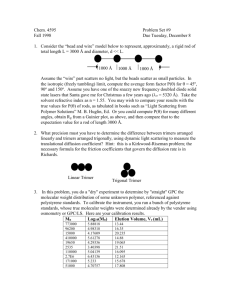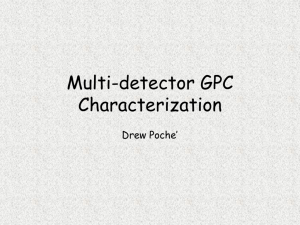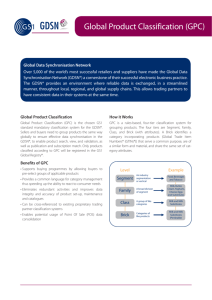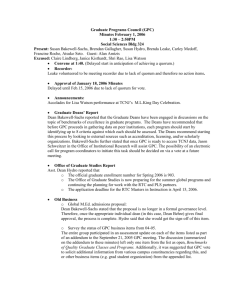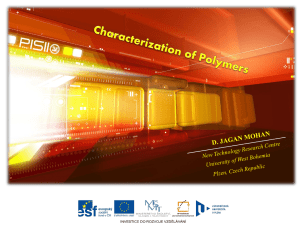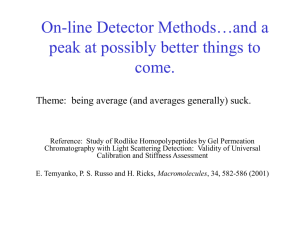Foundation Part 2
advertisement
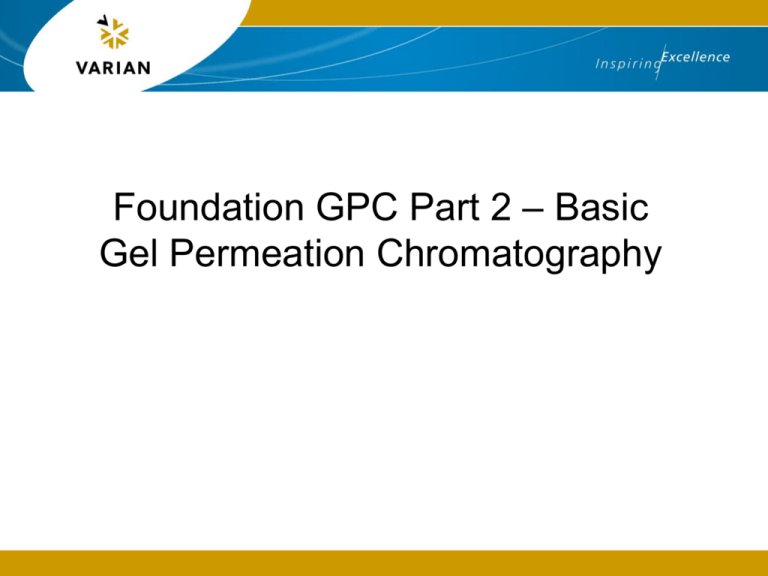
Foundation GPC Part 2 – Basic Gel Permeation Chromatography Introduction This presentation introduces gel permeation chromatography (GPC) The mechanism of GPC shall be discussed The method of analysing data shall be introduced 2 Types of Liquid Chromatography Interactive adsorption, partition, ion exchange, etc Non-interactive GPC, SEC, GFC 3 Nomenclature 4 Gel Permeation Chromatography GPC Size Exclusion Chromatography SEC Gel Filtration Chromatography GFC What is a GPC System? 5 1. Reciprocating piston pump delivers eluent from reservoir at a constant volumetric flow rate. GPC is always an isocratic separation 2. Two position injection valve permits introduction of sample solution without interrupting solvent flow. GPC tends to use larger injection volumes than HPLC (typically up to 200ul) 3. GPC columns perform a separation based on the molecular size of polymer molecules in solution. Resolution and/or resolving range is increased by use of multiple column systems 4. Detector responds to concentration of polymer molecules eluting from the GPC columns Additional Components Used in GPC Concentration detectors Differential refractometer (RI) Ultraviolet absorbance (UV) Evaporative light scattering or mass detector (ELS, EMD) Infra-red (IR) Molecular weight sensitive detectors Viscometry Light scattering Additional systems 6 Online degasser Autosampler Column oven Additional specific detectors Polymer Molecules in Solution GPC is based on the behaviour of polymer molecules in solution In the solid state polymers can be considered like spaghetti – a confusing mass of intertwined chains In solution, polymer molecules are discrete entities Due to entrophic effects all but the most rigid of polymer chains curls up in solution to form a ball like shape 7 GPC Column Packings GPC columns are packing with cross-linked, insoluble beads, typically copolymers of styrene and divinyl benzene for organic GPC These beads have a rigid pore structure that remains intact in the presence of solvent 8 Synthesis of Porous Beads High cross-link content gives a rigid, low swelling product with a welldefined pore structure 9 Permeation of Polymer Molecules Polymer coils in solution can permeate the pores on GPC packing materials Exclusion, partial permeation and total permeation are possible 10 GPC Separation Mechanism 11 Polymer is prepared as a dilute solution in the eluent and injected into the system The GPC column is packed with porous beads of controlled porosity and particle size Large molecules are not able to permeate all of the pores and have a shorter residence time in the column Small molecules permeate deep into the porous matrix and have a long residence time in the column Polymer molecules are separated according to molecular size, eluting largest first, smallest last Elution Profiles 12 As a result of the GPC separation mechanism, polymer molecules elute from the column in order of size in solution Largest elute first, smallest elute last The separation is purely a physical partitioning, there is no interaction or binding The separation is isocratic If polymer molecules have the same molecular dimensions, they will co-elute by GPC and may not be separated by this technique The calibration curve describes how different size molecules elute from the column GPC Column Technology Columns are packed with porous particles, controlled pore size and particle size Columns are produced by slurry packing technique, packed at pressures in excess of 2000psi Column dimensions typically 7-8mm i.d., 250-600mm in length Exclusion volume (Vo) - Upper MW limit (also known as void volume) Total permeation volume (Vt) – Lower MW limit Pore volume (Vp) – Working resolving range of MW Vp = Vt - Vo 13 Typical Calibration Curves for PLgel Individual Pore Size Columns 14 Determination of Polymer Molecular Weight Distribution by GPC 15 Produce a GPC calibration curve for the column set relating log M to retention time (RT) Chromatograph the polymer sample Normalise and integrate the GPC response versus retention time plot for the polymer sample Convert retention time to logM via the GPC calibration curve Present a logM distribution plot and calculate molecular weight averages (Mn, Mw) for the distribution Peak Integration in GPC The sample peak when integrated can be assumed to be a histogram consisting of a number of individual “slices” For each slice, i, the molecular weight (Mi) can be derived from the RT and the number of molecules (Ni) from the detector response 16 Calibration of GPC Columns Using Narrow Standards 17 Chromatograph a series of well characterised, narrow polydispersity polymer standards Plot peak retention time (RT) versus peak log molecular weight (logM) Fit the data using a mathematical function The calibration curve will be characteristic of the GPC column set used Performing Narrow Standard GPC Calibration Injections of multiple narrow standards reduces the time taken to calibrate the system Injection 1 Injection 2 Standards peaks in each chromatogram must be fully resolved to obtain repeatable retention times 18 EasiCal Pre-prepared Calibrants Spatula B Spatula A EasiCal PS-1 separation on 3 x PLgel 10µm MIXED-B 19 Narrow Standards Available from PL 20 Polymer Calibrants for GPC Mn - number average molecular weight Mw - weight average molecular weight Mv - viscosity average molecular weight Mp - peak molecular weight Mw/Mn - polydispersity by GPC Must be extremely well characterised Most commonly used polymer calibrants Polystyrene - THF, toluene, chloroform, TCB Polymethyl methacrylate - MEK, ethyl acetate, acetone, DMF Polyethylene oxide/glycol - aqueous eluents, DMF, DMSO 21 Example Certificates of Analysis Individual standard 22 EasiVial Calibration Methods for Conventional GPC Aim : to produce a mathematical model for log M versus retention time Narrow standards Broad standards 23 Hamielec Broad on Narrow Integral Curve Fitting for Narrow Standards Calibration Polynomial All data points fitted with one function of the form Log M = A + B(t) Linear (1st order) Log M = A + B(t) + C(t2) Quadratic (2nd order) Log M = A + B(t) + C(t2) + D(t3) Cubic (3rd order) Cubic spline Sets of points fitted with a series of cubic equations Point to point Points fitted with a series of linear equations 24 Calibration of GPC Columns Using Narrow Standards 25 Chromatograph a series of well characterised, narrow polydispersity polymer standards Plot peak retention time (RT) versus peak log molecular weight (logM) Fit the data using a mathematical function (e.g. polynomial order 1,2,3, etc) The calibration curve will be characteristic of the GPC column set used Errors Due to Limited Calibration Region The column calibration should cover the full elution time region of the sample to avoid errors due to extrapolation 26 Broad Standard Calibration Hamielec Method Requires a single polydisperse sample where Mn and Mw are known Assumes a linear calibration Log M = A + B(t) Requires only a single injection to calibrate 1. Chromatograph broad standard 2. Input actual Mn and Mw 3. Computer searches for suitable values of A and B that when back calculated give the correct values for Mn and Mw 27 Broad Standard Calibration Broad on Narrow Method Requires a series of narrow standards plus a broad standard of known Mn and Mw Valid for non-linear calibration curves Requires several injections to calibrate 1. Chromatograph the narrow standards and fit the data with a mathematical function log Mns = F(t) 2. Input the Mn and the Mw values for the broad standard 3. Chromatograph the broad standard 28 Broad Standard Calibration Broad on Narrow Method Universal Calibration theory predicts that log Mbs = log (Kns/Kbs) + (1+abs) (1+ans) log Mns (1+abs) As Kns, Kbs, ans and abs are constants this can be simplified to log Mbs = A log Mns + B The computer searches for suitable values of A and B that results in the correct values of Mn and Mw for the broad standards when back calculated. 29 Broad Standard Calibration Integral Method Requires a broad standard which has been fully characterised to give a cumulative molecular weight table, e.g. Log M 2.800 2.865 2.929 ….. 5.705 5.789 5.870 30 Wt % 0.000 0.005 0.020 99.80 99.99 100.00 Accuracy is improved with increased number of data points, usually 50-60 points are used There are few broad standards available with this level of characterisation Broad Standard Calibration Integral Method The broad standard is chromatographed and integrated, the log M values are assigned to the distribution based on the wt % values quoted in the table. This results in a calibration table with as many points as there are entries in the table. The Log M versus retention time data is then fitted with a mathematical function as usual. 31 Use of Mark-Houwink Constants in GPC There are few well characterised polymer standards for GPC calibration. Therefore “unknown” polymer molecular weight can be derived from a GPC calibration curve obtained using polymer standards and applying the following theory: Molecular size = hydrodynamic volume (HV) HV = M [n], where M is molecular weight and [n] is intrinsic viscosity In GPC molecules with the same HV elute at the same retention time Therefore for different polymer types M1 [n]1=M2 [n]2 For a given polymer system Mark-Houwink equation applies : [n] = K M Rearranging these relationships logM2 = log(K1/K2) + (1+ 1) logM1 (1+ 2) (1+ 2) where K1, 1 for polymer standards and K2, 2 for polymer under investigation are known 32 Interpreting Chromatograms The data obtained in a GPC experiment will be in the form of a chromatogram showing detector response as a function of retention time There are fundamental parameters that are present on all chromatograms 33 Peak Separation Peak separation in GPC is dependent upon resolution and on molecular size If two samples have different molecular sizes, then they will be separated to baseline assuming there is sufficient resolution However, if samples are the same molecular size, then they cannot be separated by GPC as the mechanism of SEC is based upon size 34 If two peaks are not baseline resolved in GPC, they cannot be analysed as two separate peaks Although the calculations will give you results, the numbers will be meaningless as not all of the peak is defined and so the distribution will not be correct 35 Excluded Peaks 36 Partial Exclusion The dead space of the separation will be around half of the total elution volume Peaks eluting close to this volume may be partially excluded Look for sharp peaks at the front of your chromatograms 37 Oligomeric Resolution In GPC, the relationship between molecular weight and retention time is logarithmic As a result, peaks equidistant in molecular weight elute closer together with increasing molecular weight This is a classic way to tell a separation is based on SEC 38 With some columns it is possible to calibrate the column using the oligomers The molecular weights of the initiator fragment and the repeat unit of the polymer must be known 39 Interpreting Molecular Weight Distributions The molecular weight distribution shows the amount of material present as a function of the molecular weight The MWD looks a bit like a ‘mirror image’ of chromatogram 40 the Effect of Baseline Position 41 The whole peak should be analysed to get a true reflection of the sample The peak should go down to the baseline on either side Leaving out components of the peak will leave an ‘incomplete’ MWD 42
